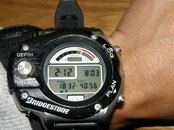I did 2 tank dives at the depth of average 45ft, 70mins each.
Then waited 24hrs, following the standard rule. My dive computer said I was desaturated at that time.
Then I started to drive to 9000ft mountain. At around 8000ft, residual nitrogen level went from 0 to 70%, with desaturation time of 15hrs. I got scared and turned around, stayed at sea level for additional 16hrs.
At 40hrs after the dive, I started driving up again, then at 9000ft, nitrogen level went up to 70% again. It was zero at the sea level.
I do not understand what is going on. My dive computer is wrong? Is there any guidelines how long I need to wait before going up to 9000ft?
I attach a pic of my dive computer, showing high level of nitrogen after 40hrs of surface time.
Comments appreciated.
Then waited 24hrs, following the standard rule. My dive computer said I was desaturated at that time.
Then I started to drive to 9000ft mountain. At around 8000ft, residual nitrogen level went from 0 to 70%, with desaturation time of 15hrs. I got scared and turned around, stayed at sea level for additional 16hrs.
At 40hrs after the dive, I started driving up again, then at 9000ft, nitrogen level went up to 70% again. It was zero at the sea level.
I do not understand what is going on. My dive computer is wrong? Is there any guidelines how long I need to wait before going up to 9000ft?
I attach a pic of my dive computer, showing high level of nitrogen after 40hrs of surface time.
Comments appreciated.




